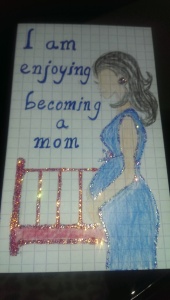April 25th, 2014 is a day my husband and I will never forget. At a routine 20 week growth ultrasound, my little Pumpkin was in a transverse position making it challenging for the doctors to see his heart. After a couple of hours trying to shift positions, drinking some juice and moving, my little Pumpkin did not budge. So we were asked to come again in a few days – this time around Pumpkin was in a breach position again causing challenges to the doctors to see his heart. So we were asked to go and get Fetal Echocardiagram or fetal echo as those doctors have very powerful ultrasound machines that can see heart structures in spite of little munchkins being in any position… I was getting nervous and something kept bothering me as to why the doctors are after my baby’s heart – is it something that are seeing that would warrant a specialized heart echo.
My heart was racing watching the technician look at our baby’s heart during the fetal echo. We knew the technician could not answer any of our questions but I still tried asking basic questions to see if there were 4 heart chambers. She said nothing and after 3 hours of ultrasound, got the cardiologist in. She then looked at the images further and told us that she saw some abnormality in our little Pumpkin’s heart. At this time, our world came shattering down and I was already holding back my tears. She showed us 2 structural heart diagrams – one of a normal heart and one of our baby’s showing us how his heart was different as it represented itself in the form of Transposition of Greater Arteries (TGA).
Thus began our journey over the many months in an attempt to understand what CHD is and in particular what TGA was. I kept on telling myself that I should still enjoy the process of becoming a mom and eventually when I do become a mom. I ended up creating a simple art piece to remind myself during my entire pregnancy to help me. I must say it gave me all the courage to go through the entire 41 weeks and eventually give birth to our Pumpkin without any drugs.
Something to pay heed and we did not know at that time is that the most basic part of correcting TGA is the Arterial Switch Operation (ASO) in which the the arteries are switched back to the right position. However what makes the surgery complicated and where things can go very wrong as it happened in our case are the coronary arteries. This is because there are millions of configurations of how coronaries may be structured and because they are so tiny, performing the switch impacts these tiny minuscule structures. Further, the exact configuration or anatomy of these coronaries cannot be seen by fetal echo – these are only seen for the first time when the baby’s chest is cut open i.e. at the time of the ASO. Thus, correcting or working the coronaries really depends on the skill, experience and knowledge of the surgeon – one definitely would hope that however rare or complicated this structure is, the surgeon may have seen something similar in one of his previous surgeries and your own baby is not the first. We came to know about this only when our baby’s heart failed and we were readmitted to the ICU once again where he was fighting for his life.
I still struggle often times reconciling why this happened to our baby or why we did not do things differently as I mentioned in my last post. I know that I cannot change the past, my husband tells me that every time I get emotional, its more than 3 months since our baby’s birth but this still gets me. I suppose I may be feeling angry, guilty and even envious of other parents when I see what looks a very normal way of taking care of one’s baby or the fact that our baby was continuously posted for 6-7 hours straight on multiple occasions to get his ART line or just one of the PIC lines. Is it wrong to feel this way when I see other babies? Maybe…
